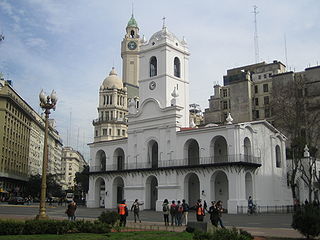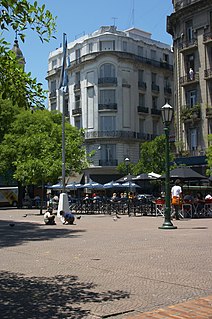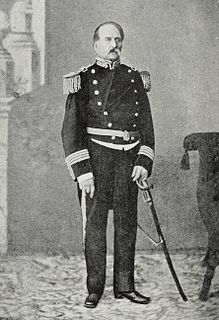
Buenos Aires is the capital and largest city of Argentina. The city is located on the western shore of the estuary of the Río de la Plata, on the South American continent's southeastern coast. "Buenos Aires" can be translated as "fair winds" or "good airs", but the former was the meaning intended by the founders in the 16th century, by the use of the original name "Real de Nuestra Señora Santa María del Buen Ayre". The Greater Buenos Aires conurbation, which also includes several Buenos Aires Province districts, constitutes the fourth-most populous metropolitan area in the Americas, with a population of around 15.6 million.

Colonia del Sacramento is a city in southwestern Uruguay, by the Río de la Plata, facing Buenos Aires, Argentina. It is one of the oldest towns in Uruguay and capital of the Colonia Department. It has a population of around 27,000.

The Plaza de Mayo is a city square and main foundational site of Buenos Aires, Argentina. It was formed in 1884 after the demolition of the Recova building, unifying the city's Plaza Mayor and Plaza de Armas, by that time known as Plaza de la Victoria and Plaza 25 de Mayo respectively. The city centre of Buenos Aires, Plaza de Mayo has been the scene of the most momentous events in Argentine history, as well as the largest popular demonstrations in the country. On the occasion of the one-year anniversary of the May Revolution in 1811, the Pirámide de Mayo was inaugurated in the square's hub, becoming Buenos Aires' first national monument.

The Buenos Aires Underground, locally known as Subte, is a rapid transit system that serves the area of the city of Buenos Aires, Argentina. The first section of this network opened in 1913, making it the 13th subway in the world, and first underground railway in Latin America, the Southern Hemisphere and the Spanish-speaking world, with the Madrid Metro opening five years later, in 1919. As of 2015, Buenos Aires is the only Argentine city with a metro system, but there is a proposal to build a metro in the city of Córdoba, while a proposal to build a metro in Rosario was shelved in favour of a tramway network.

The Buenos Aires Cabildo is the public building in Buenos Aires that was used as seat of the town council during the colonial era and the government house of the Viceroyalty of the Río de la Plata. Today the building is used as a museum.

The General San Martín Cultural Centre is a cultural centre located in Buenos Aires, Argentina near the major thoroughfare Corrientes Avenue.

Buenos Aires is in the midst of a tourism boom, according to the World Travel & Tourism Council, which reveals strong growth for Argentina Travel and Tourism in 2007 and in coming years, and the prestigious travel and tourism publication; Travel + Leisure, a monthly magazine, travelers voted Buenos Aires the second most desirable city to visit after Florence, Italy. Buenos Aires, regarded as the “Paris of South America”, offers elegant architecture, exquisite cuisine, a legendary nightlife, and fashionable shopping. Argentina has become famous for its rich European flavor.

Plaza Dorrego is a square located in the heart of San Telmo, in Buenos Aires, Argentina. In the 19th century, San Telmo was the main residential barrio (neighbourhood) of the city and Plaza Dorrego was its focal point.

Plaza de Mayo is a station on Line A of the Buenos Aires Underground. This station belonged to the first section of line opened on 1 December 1913, linking the station with the station of Plaza Miserere.

The Buenos Aires Metrobus is a 50.5 km (31.4 mi) network of dedicated separated lanes and stations for normal buses that serve the city of Buenos Aires, Argentina. Designed as a Bus Rapid Transit system, it mixes a few bi-articulated buses with conventional buses. The headway is the same as before the implementation of the system, and it lacks the brand of the network in the buses that use it, maintaining their previous branding as common bus lines with their own numbers. The service operates 24 hours a day and 365 days a year, with 2-4 minute frequencies during the day and 10-15 minutes at night.

Mateo Leal de Ayala (1579-1627) was a Spanish army officer and politician, who served during the Viceroyalty of Peru as alcalde, teniente de gobernador and gobernador of Buenos Aires and Paraguay.
Sinforoso Canavery was an Argentine jurist, who served as a notary public in the cities of Buenos Aires and La Plata, and as Notary Mayor of Government of Buenos Aires Province towards the end of the 19th century.

The Hospital of Psychiatric Emergencies Marcelo Torcuato de Alvear is a monovalent public hospital for acute psychiatric patients in the city of Buenos Aires, Argentina.

Enrique Sinclair (1805-1904) was an Argentine military officer of American origin. He had an outstanding performance serving in the Navy of Admiral Brown, participating heroically in the Battle of Juncal.

Mariano Billinghurst (1810–1892) was an Argentine businessman and politician, pioneer in the construction of the national railroads. The locality of Billinghurst in the Great Buenos Aires, and a street (Billinghurst) in Buenos Aires City takes its name in his honor.

Plaza de Toros del Retiro was a bullfighting coliseum of Buenos Aires of the 19th century. This Arena was established in the city during the last years of the colonial period.
Plaza de Toros de Montserrat was a Spanish colonial auditorium of bullfighting shows. It was located in the suburbs of the neighborhood of Montserrat.

Our Lady of Mercy Church of Buenos Aires is an Argentine Catholic temple. It is located on Calle Reconquista 207, in the Buenos Aires neighborhood of San Nicolas.

A la Ciudad de Londres was a traditional European store, which operated Buenos Aires from 1872 to 1922. It was the first large clothing store established in the city of Buenos Aires towards the end of the 19th century.





















